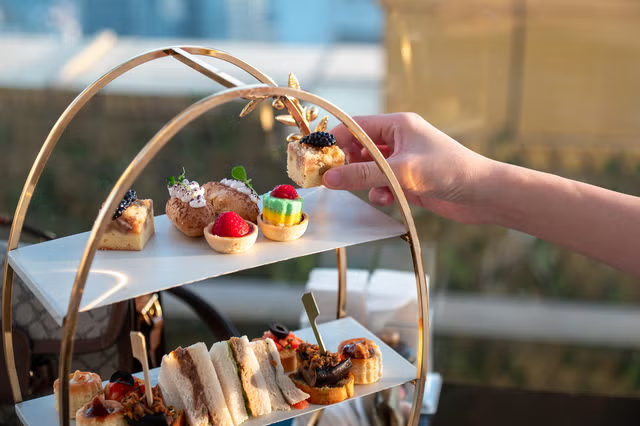As the Venice Film Festival swings into overdrive this weekend, Hollywood’s finest have much more than sequins and bugle beads resting on their taut shoulders.
With the shaky global economy impacting the luxury goods sector, the pressure is on celebrity brand ambassadors to boost retail sales and create demand for high fashion by starring in those iconic red carpet moments that precede films premiering at the glamorous Italian cinema forum.
A newsworthy celebrity flaunting an intriguing evening gown that generates drama can also create demand. Not just for the actual garment, but also for more affordable items that are part of the spectacle. Think cosmetics, perfume and accessories.
Fiscal issues aside, another big problem has complicated the tried and tested formula that has fueled the fashion business for decades. According to Kate Young, a Hollywood “power stylist,” there are fewer gowns than ever to dress celebrities for autumn’s round of film festivals including the Toronto International Film Festival, which starts later next week.
Young – who assembles looks for Julianne Moore, Sienna Miller and Rachel Weisz – attributes the gown shortage to a host of factors that are knock-on effects of the contracting economy. “Brands just don’t show gowns anymore,” she told Lauren Sherman of Puck News. “In the past, a brand like Louis Vuitton or Bottega Veneta would have some gowns mixed in [to their runway collection]. There are fewer couture shows than there used to be, so therefore less gowns, and even more daywear in couture.”

Fashion show finales were once dominated by evening gown parades. But a quick survey of the autumn/winter shows staged by A-list designers verifies Young’s assertion. At Dior, where creative director Maria Grazia Chiuri gleaned inspiration from the trouser-clad screen siren, Marlene Dietrich, seven gowns featured among the 72 looks presented.
The lonely feeling of the one long strapless black dress that made the cut at Gucci’s show – where the focus was the coat (creative director Sabato De Sarno’s “obsession…”) – evoked the Italian mega brand’s financial woes. Gucci’s sales dropped by 19 per cent in the second quarter of 2024. Alluding to the designer’s former strategy of dressing legions of celebrities for film festivals, Young admitted: “Gucci isn’t dressing as many people.” Chanel gowns have appeared in Venice. But at the brand’s couture show in July, the ruffled cape was the statement piece.
Designers who are celebrity darlings – as well as dab hands at conceiving seductive long dresses – are either dead, gone from their namesake brands or at large, as they wait for the top posts at Chanel, Givenchy and Dries Van Noten to be filled. “We don’t have Alber Elbaz or Riccardo Tisci or Claire Waight Keller, people who found a way to do really smart, high-concept evening gowns,” lamented Young.
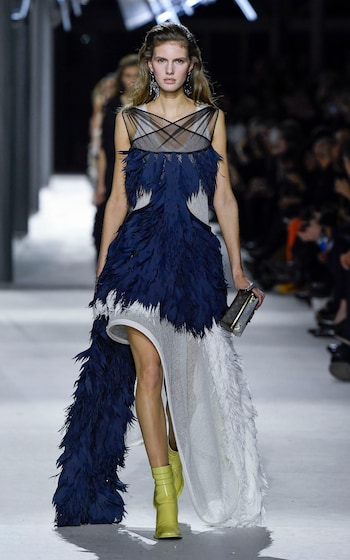
Of course, gowns are available in department stores and fashion boutiques across the UK. Back in December, Harrods responded to a 50 per cent uptick in the sale of dressy nighttime clothing by launching the Evening & Occasion Room. Net-A-Porter is deeply committed to evening gown curation, confirms Libby Page, the online fashion retailer’s market director.
“We work with brands on bespoke pieces so that when our customer buys something exclusive, the risk of them attending an event where someone else is wearing the same piece is minimal,” explains Page. “The customer is looking for something that will embody their personal style, but that will feel unique and interesting. An evening gown is a huge investment so it must feel very true to you as an individual, so that you get your wear out of it, whilst also not being something that everyone else might own.”
In the lead-up to London Fashion Week, ateliers operated by designers who uphold the capital’s tradition of expert gown –making are also thriving. “A gown is often a central part of our collection,” says high-end fashion designer Emilia Wickstead, explaining that the burgundy sequin Nehemia gown was her autumn collection’s “standout” number. “Our clients seek out evening gowns all year round, with demand stronger than ever, particularly for bespoke. We have a team now dedicated to this sector of our business.”
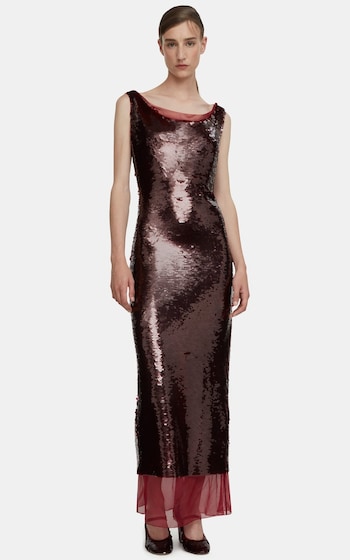
Edeline Lee – whose sleek evening dresses are favourites of First Lady Victoria Starmer, as well as Phoebe Waller-Bridge and Helen Mirren – concurs. “We work directly with our clients, often on a case-by-case basis and the demand for gowns is constant,” she says. “My clients are women who need to show up and make a statement. Wearing a gown is the best way to do that.”
Ankle-grazing, flouncy, one embellished with beauteous silken fringe and others with inventive trains – so many sumptuous gowns dominated Erdem’s autumn/winter collection. It was inspired by Maria Callas, the opera diva who Angelina Jolie immortalizes in Maria, Pablo Larrain’s biopic, which received its world premiere in Venice on Thursday evening with Jolie wearing a custom Tamara Ralph gown for the moment.
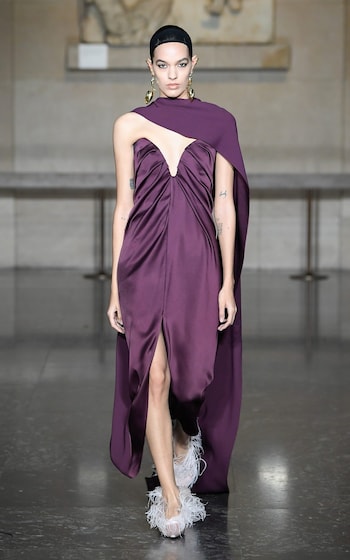
But back in the real world, tariffs imposed by Brexit, the recent implosion of the luxury fashion retailer Matches and the end of tax-free shopping in the UK have heralded the demise of a generation of London designers whose stock in trade was edgy-cool evening dresses, including Halpern, Christopher Kane, and The Vampire’s Wife. These independent names were once a valuable resource for those of us out there shopping for gowns because their small batch production levels and price points (which were at the more affordable end of the market than Milan and Paris-made garb), heightened the feel-good factor that a fancy dress purchase can deliver.
The London contemporary art dealer, Emily Tsingou was a loyal Christopher Kane client and she wears a lot of Edeline Lee. She noticed a lack of gowns on Bond Street and beyond when the task of hosting her daughter’s recent 21st birthday involved sourcing one for the black tie occasion.
“There are lots of cocktail dresses out there, but you can’t find evening dresses,” confirms Tsingou. “A lot of boutiques don’t stock them. And the designers that do make them – some of the big brands – their gowns scream ‘Advert.’ So you know, when you wear the dress, immediately it will be recognized because it has already appeared in a Dior or Dolce & Gabbana advertisement or on their Instagram feed. So wearing one of those – it just makes you feel like you’re ticking somebody else’s box.”
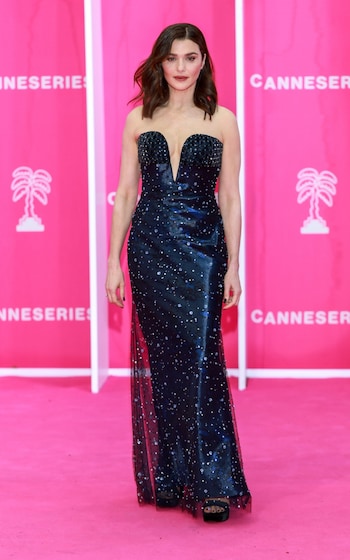
Ultimately, what saved Tsingou was a relationship she had cultivated with a sales associate at Gucci who sourced a long floral dress from a capsule collection produced for Ramadan. “It wasn’t hanging up in the boutique,” elaborates Tsingou. “They showed me a photograph and explained that it could be sourced. A lot of designer boutiques have become very relationship driven and if you don’t have the contacts and you are looking for a dress for a specific occasion, you might not find one.”
British Vogue’s editor-at-large, Sarah Harris takes an optimistic view of the sartorial shift. The gown cutback is an opportunity to opt for an eveningwear alternative that designers are creating such as a jumpsuit, a tuxedo or embellished separates that are fit for a black tie. “The idea of an evening gown has widened so much in recent years that it’s now something we see in multiple incarnations,” observes Harris. “The idea of a ‘traditional’ gown perhaps isn’t as relevant as it once was. There are now so many options women find it hard to navigate through the choices.”
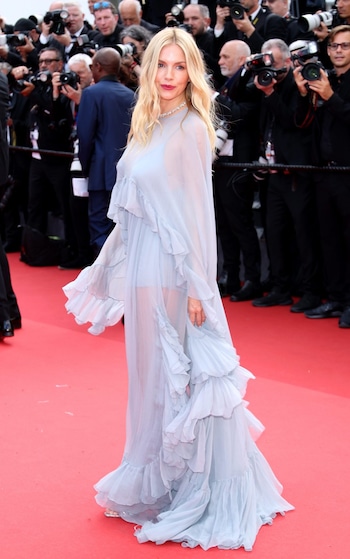
The Princess of Wales – who countless women around the world look to for gown inspiration, has been mostly absent from the spotlight this year. The one truly big gown moment from the House of Windsor was generated by Meghan, Duchess of Sussex. The white halter neck column which she wore supporting Prince Harry at July’s ESPY Awards went viral because for a day, or so, its makers – Oscar de la Renta’s design duo, Laura Kim and Fernando Garcia – were a mystery.
Next month’s royal tour of Australia and Samoa should see Queen Camilla gowned, gem-laden and gorgeous. Until then, Sarah Harris advises gown shoppers to check out what Cate Blanchett, Lady Gaga, Penélope Cruz, Nicole Kidman and Diane Kruger wear at Venice.
“Runways and red carpets might sometimes be unrealistic forums from which to emulate a head-to-toe look,” admits Harris. “But I think they’re great places to look for ideas and inspiration.
Disclaimer: The copyright of this article belongs to the original author. Reposting this article is solely for the purpose of information dissemination and does not constitute any investment advice. If there is any infringement, please contact us immediately. We will make corrections or deletions as necessary. Thank you.
